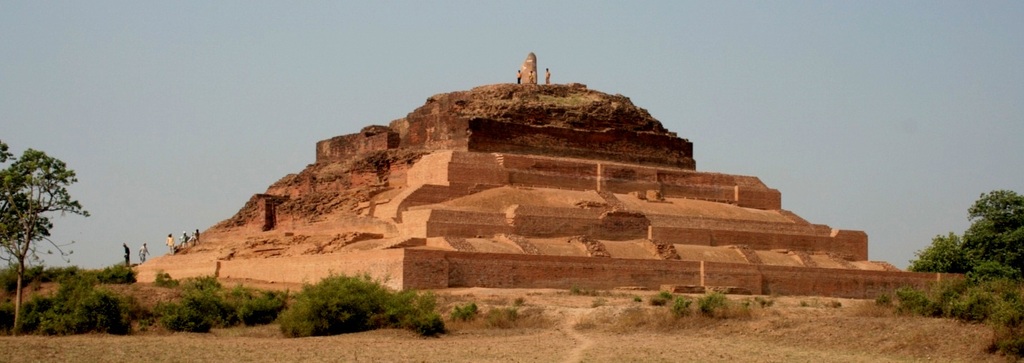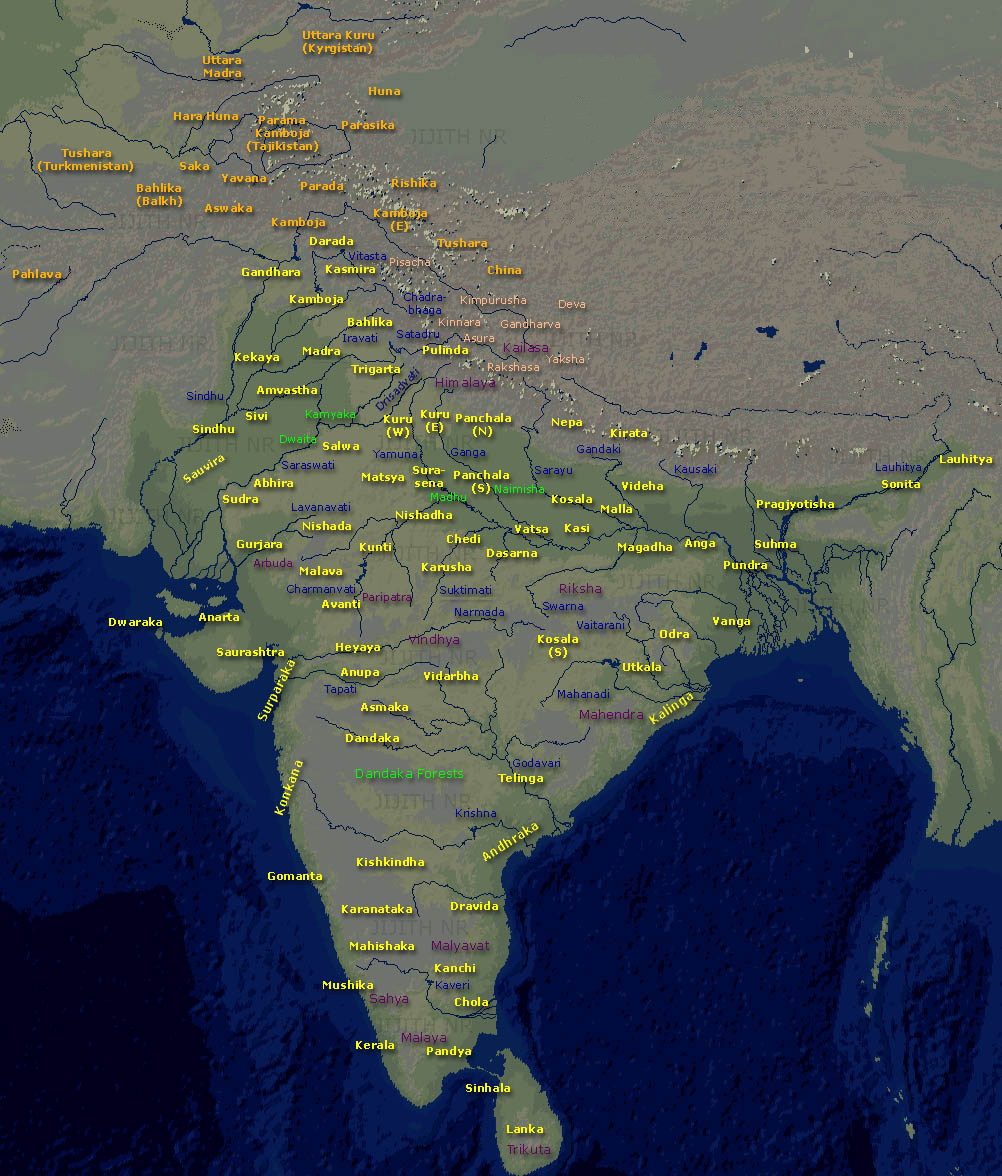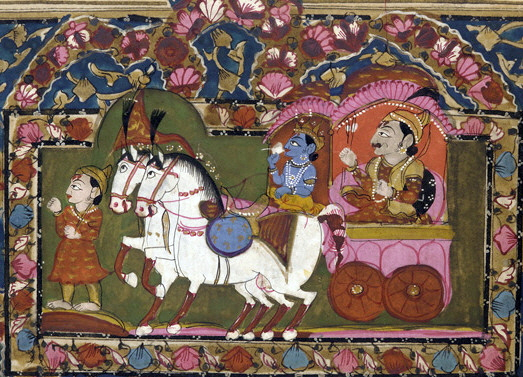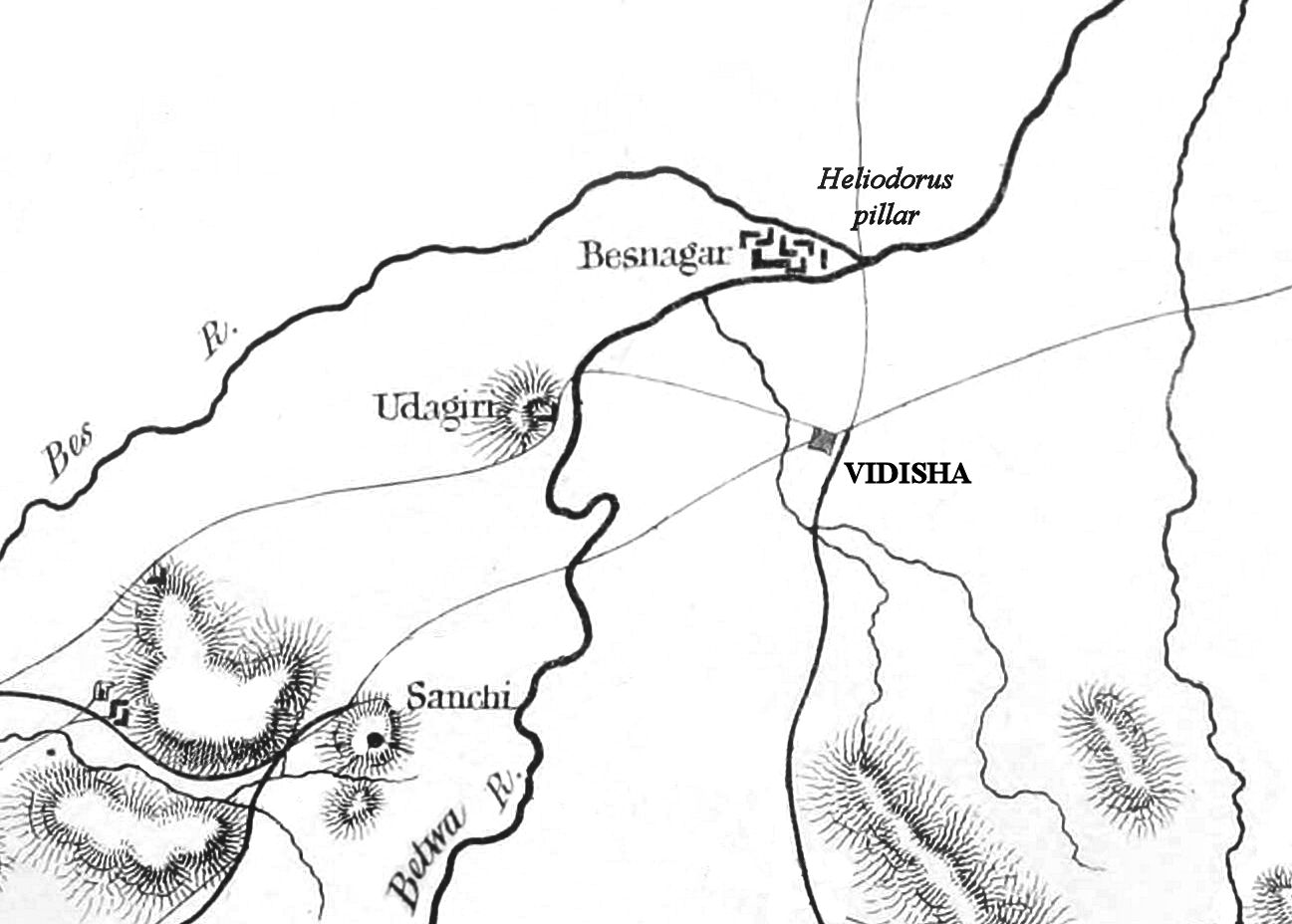|
Dasharna
Dasharna (Sanskrit:दशार्ण ) was an ancient Indian janapada (realm) in eastern Malwa region between the Dhasan River and the Betwa River. The name of the janapada was derived from the , the ancient name of the Dhasan River. The janapada was also known as ''Akara'' and Rudradaman I in his Junagarh rock inscription referred to this region by this name. Kalidasa in his Meghaduta (''Purvamegha'', 24-25) mentioned the city of Vidisha as the capital of Dasharna. Other important cities of this janapada were Erakina and Erikachha. According to the Mahabharata, the queen of king Virabahu or Subahu of Chedi kingdom and the queen of king Bhima of Vidarbha (the mother of Damayanti) were daughters of the king of Dasharna. King Ashadhamitra of Dasharna A brick inscription from Erich The given name Eric, Erich, Erikk, Erik, Erick, or Eirik is derived from the Old Norse name ''Eiríkr'' (or ''Eríkr'' in Old East Norse due to monophthongization). The first element, ... [...More Info...] [...Related Items...] OR: [Wikipedia] [Google] [Baidu] |
Dasharna Historical Region
Dasharna (Sanskrit:दशार्ण ) was an ancient Indian janapada (realm) in eastern Malwa region between the Dhasan River and the Betwa River. The name of the janapada was derived from the , the ancient name of the Dhasan River. The janapada was also known as ''Akara'' and Rudradaman I in his Junagarh rock inscription referred to this region by this name. Kalidasa in his Meghaduta (''Purvamegha'', 24-25) mentioned the city of Vidisha as the capital of Dasharna. Other important cities of this janapada were Erakina and Erikachha. According to the Mahabharata, the queen of king Virabahu or Subahu of Chedi kingdom and the queen of king Bhima of Vidarbha (the mother of Damayanti) were daughters of the king of Dasharna. King Ashadhamitra of Dasharna A brick inscription from Erich The given name Eric, Erich, Erikk, Erik, Erick, or Eirik is derived from the Old Norse name ''Eiríkr'' (or ''Eríkr'' in Old East Norse due to monophthongization). The first element, ''ei- ... [...More Info...] [...Related Items...] OR: [Wikipedia] [Google] [Baidu] |
Dhasan River
The Dhasan River is a river in central India. A right bank tributary of the Betwa River, it originates in Begumganj tehsil (Raisen district, Madhya Pradesh). The river forms the southeastern boundary of the Lalitpur District of Uttar Pradesh state. Its total length is 365 km, out of which 240 km lies in Madhya Pradesh, 54 km common boundary between Madhya Pradesh and Uttar Pradesh, and 71 km in Uttar Pradesh. Bela, Kathan, Mangrar, Bachneri and Rohni are among its tributaries. Human Activity Two dams have been built on Dhasan: one at Pahari and one further down at Lahchura. A three-branched irrigational canal was opened in 1910, diverting some of the river's flow and providing water for the Bundelkhand Bundelkhand (, ) is a geographical and cultural region and a proposed state and also a mountain range in central & North India. The hilly region is now divided between the states of Uttar Pradesh and Madhya Pradesh, with the larger portion lying ... re ... [...More Info...] [...Related Items...] OR: [Wikipedia] [Google] [Baidu] |
Janapada
The Janapadas () (c. 1500–600 BCE) were the realms, republics (ganapada) and monarchy, kingdoms (saamarajya) of the Vedic period on the Indian subcontinent. The Vedic period reaches from the late Bronze Age India, Bronze Age into the Iron Age India, Iron Age: from about 1500 BCE to the 6th century BCE. With the rise of sixteen ''Mahajanapadas'' ("great janapadas"), most of the states were Annexation, annexed by more powerful neighbours, although some remained independent. Etymology The Sanskrit term ''janapada'' is a tatpurusha compound term, composed of two words: ''janas'' and ''pada''. ''Jana'' means "people" or "subject" (cf. Latin cognate ''genus'', English language, English cognate ''kin''). The word ''pada'' means "foot" (cf. Latin cognate ''pedis''); from its earliest attestation, the word has had a double meaning of "realm, territory" and "subject population" (cf. Hittite ''pedan'', "place"). Linguist George Dunkel compares the Greek language, Greek ''andrapodon'' ... [...More Info...] [...Related Items...] OR: [Wikipedia] [Google] [Baidu] |
Erich (town)
Erich is a town and a nagar panchayat in Jhansi district in the state of Uttar Pradesh, India. In ancient period it was known as ''Erikachha'' or ''Erakachha'' and according to a Buddhist text, the Petavatthu it was one of the major cities of the Dasanna janapada. History Bhakt Prahlad was born in Erich and Holika Dehan first took place Erich. The names of a number of rulers of Erich during the post-Maurya period are found from the coins issued by them. They are Sahasamitra, Ishvaramitra, Sahasrasena, Mitrasena, Amitasena and Maha (sena?). At the time of the Mughal emperor Akbar, Erich was the seat of a sarkar in Agra Subah. It also formed a constituent mahal of the sarkar. The sarkar of Erich covered all of today's Jhansi district and much of the former Orchha State. How far south it extended is unclear, but it probably bordered the sarkar of Kanauj (or Garha Mandla) in Malwa subah. The mahal of Erich was mostly in today's Jhansi district and also included parts of what is ... [...More Info...] [...Related Items...] OR: [Wikipedia] [Google] [Baidu] |
Sanskrit Language
Sanskrit (; attributively , ; nominally , , ) is a classical language belonging to the Indo-Aryan branch of the Indo-European languages. It arose in South Asia after its predecessor languages had diffused there from the northwest in the late Bronze Age. Sanskrit is the sacred language of Hinduism, the language of classical Hindu philosophy, and of historical texts of Buddhism and Jainism. It was a link language in ancient and medieval South Asia, and upon transmission of Hindu and Buddhist culture to Southeast Asia, East Asia and Central Asia in the early medieval era, it became a language of religion and high culture, and of the political elites in some of these regions. As a result, Sanskrit had a lasting impact on the languages of South Asia, Southeast Asia and East Asia, especially in their formal and learned vocabularies. Sanskrit generally connotes several Old Indo-Aryan language varieties. The most archaic of these is the Vedic Sanskrit found in the Rig Veda, a coll ... [...More Info...] [...Related Items...] OR: [Wikipedia] [Google] [Baidu] |
Damayanti
''Damayanti'' (Sanskrit: दमयंती) is a character in a love story found in the Vana Parva book of the Mahabharata. She was the daughter of Bhima (not the Pandava one) and a princess of the Vidarbha Kingdom, who married King Nala of the Nishadha Kingdom. The character is also found in other Hindu texts by many authors in numerous Indian languages. She, along with Nala, are the central characters in the 12th century text Nishadha Charita, one of the five ''mahakavyas'' (great epic poems) in the canon of Sanskrit literature, written by Sriharsha. Story Damayanti was the Yadava princess of Vidarbha Kingdom. One day, a beautiful swan came to her and told her about Nala, king of Nishadha. The swan was sent by Nala after hearing about her from it. After hearing about Nala, she was impressed with him and wanted to marry him. A swayamvara was organized by Damayanti's father and Nala was also invited. Damayanti chose Nala out of the kings and princes and married. After a f ... [...More Info...] [...Related Items...] OR: [Wikipedia] [Google] [Baidu] |
Vidarbha
Vidarbha (Pronunciation: Help:IPA/Marathi, [ʋid̪əɾbʱə]) is a geographical region in the east of the Indian state of Maharashtra and a Proposed states and union territories of India#Maharashtra, proposed state of central India, comprising the state's Amravati Division, Amravati and Nagpur Division, Nagpur divisions. Amravati Division's former name is Berar Province, Berar (Varhad in Marathi language, Marathi). It occupies 31.6% of the total area and holds 21.3% of the total population of Maharashtra. It borders the state of Madhya Pradesh to the north, Chhattisgarh to the east, Telangana to the south and Marathwada and North Maharashtra regions of Maharashtra to the west. Situated in central India. The largest city in Vidarbha is Nagpur followed by Amravati, Akola, and Chandrapur. A majority of Vidarbhians speak Varhadi and Zadi dialects of Marathi. The Nagpur region is known for growing Orange (fruit), oranges and cotton. Vidarbha holds two-thirds of Maharashtra's mineral re ... [...More Info...] [...Related Items...] OR: [Wikipedia] [Google] [Baidu] |
Chedi Kingdom
Chedi ( sa, चेदी) was a kingdom which fell roughly in the Bundelkhand division of Madhya Pradesh regions to the south of river Yamuna along the river Ken. Its capital city was called Suktimati in Sanskrit. According to the Mahabharata, the Chedi Kingdom was ruled by Shishupala, an ally of Jarasandha of Magadha and Duryodhana of Kuru. He was a rival of Vasudeva Krishna who was his uncle's son. He was killed by Vasudeva Krishna during the Rajasuya sacrifice of the Pandava king Yudhishthira. Bhima's wife was from Chedi. Prominent Chedis during the Kurukshetra War included Damaghosha, Shishupala, Dhrishtaketu, Suketu, Sarabha, Bhima's wife, Nakula's wife Karenumati, Dhrishtaketu's sons. Other Chedis included King Uparichara Vasu, his children, King Suvahu, King Sahaja. It was ruled during early periods by ''Paurava'' kings and later by Yadava kings in the central part of the country. Puranic History The Chedi clan and kingdom was founded by Chidi, the ... [...More Info...] [...Related Items...] OR: [Wikipedia] [Google] [Baidu] |
Mahabharata
The ''Mahābhārata'' ( ; sa, महाभारतम्, ', ) is one of the two major Sanskrit epics of ancient India in Hinduism, the other being the '' Rāmāyaṇa''. It narrates the struggle between two groups of cousins in the Kurukshetra War and the fates of the Kaurava and the Pāṇḍava princes and their successors. It also contains philosophical and devotional material, such as a discussion of the four "goals of life" or ''puruṣārtha'' (12.161). Among the principal works and stories in the ''Mahābhārata'' are the ''Bhagavad Gita'', the story of Damayanti, the story of Shakuntala, the story of Pururava and Urvashi, the story of Savitri and Satyavan, the story of Kacha and Devayani, the story of Rishyasringa and an abbreviated version of the '' Rāmāyaṇa'', often considered as works in their own right. Traditionally, the authorship of the ''Mahābhārata'' is attributed to Vyāsa. There have been many attempts to unravel its historical growth ... [...More Info...] [...Related Items...] OR: [Wikipedia] [Google] [Baidu] |
Vidisha
Vidisha (विदिशा, formerly known as Bhelsa and known as Besnagar in ancient times) is a city in central Madhya Pradesh, India. It is located 62.5 km northeast of the state capital, Bhopal. The name "Vidisha" is derived from the nearby river "Bais", mentioned in the Puranas. The district was created as Bhilsa District in 1904 by joining the tehsils of Vidisha (also known as Bhilsa) and Basoda (but not Basoda State) which were then part of Gwalior state. After India's independence in 1947, the former princely state of Gwalior became part of Madhya Bharat state, which was formed in 1948. Vidishā was the administrative headquarters of Bhelsa, or Bhilsa, during the Medieval period. It was renamed Vidisha in 1956. Vidisha is also amongst the 112 Aspirational District in the Aspirational District Programme launched by NITI Aayog in 2018. Demographics As of the 2011 Census of India, Vidisha had a population of 155,959. Males constitute 53.21% of the population an ... [...More Info...] [...Related Items...] OR: [Wikipedia] [Google] [Baidu] |
Eran
Eran is an ancient town and archaeological site in the Sagar district of Madhya Pradesh, India. It was one of the ancient mints for Indian dynasties as evidenced by the diverse coins excavated here. The site has 5th and 6th-century Gupta era temples and monuments, particularly the colossal stone boar with sages and scholars depicted on the body of the sculpture. The inscription stones found at Eran are important to reconstructing the chronology of Gupta Empire history. Eran or Erakina was the capital of ''Erakina (Airikina) Pradesha'' or ''Airkina Vishaya'', an administrative division of the Gupta empire. Etymology The ancient name of Eran ( sa, ऐरण), ''Erakaina'', ''Erakanya'' or ''Erakina'' (as mentioned in the inscriptions); ''Airikina'' ( sa, ऐरिकिण, as mentioned in the inscription of Samudragupta) or ''Erikina'' (as mentioned in the inscription of Toramana) is derived from ''Eraka''. The word ''erakā'' probably refers to a tall grass commonly called t ... [...More Info...] [...Related Items...] OR: [Wikipedia] [Google] [Baidu] |
Ancient Indian
The following outline is provided as an overview of and topical guide to ancient India: Ancient India is the Indian subcontinent from prehistoric times to the start of Medieval India, which is typically dated (when the term is still used) to the end of the Gupta Empire around 500 CE. Depending on context, the term Ancient India might cover the modern-day countries of Afghanistan, Sri Lanka, Bangladesh, India, Nepal and Pakistan, though these territories had large cultural differences. General history of Ancient India An elaborate periodisation may be as follows: Pre-history (Neolithic Age) (c. 8000–3500 BCE) * Indian Pre-history Age (c. 10,000–3300 BCE) * Bhirrana culture (7570–6200 BCE) * Mehrgarh culture (c. 7000 –2500 BCE) Bronze Age India (c. 3500–1750 BCE) * Indus Valley Civilisation (c. 3300–1300 BCE) * Ahar–Banas culture (c. 3000–1500 BCE) * Ochre Coloured Pottery culture (c. 2600–1200 BCE) * Cemetery H culture (c. 1900–1300 BCE) ... [...More Info...] [...Related Items...] OR: [Wikipedia] [Google] [Baidu] |








